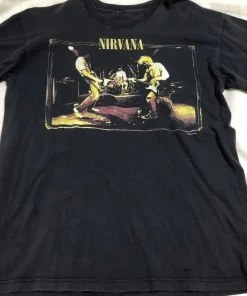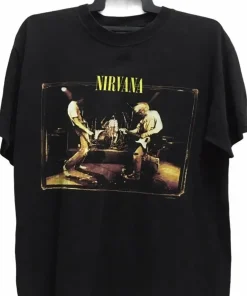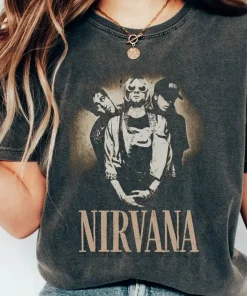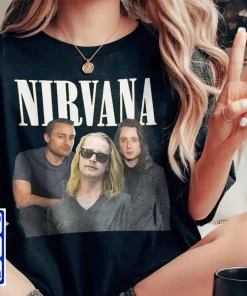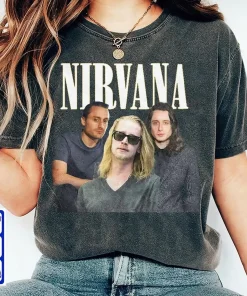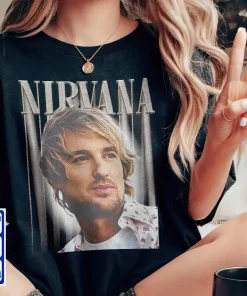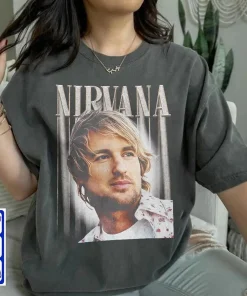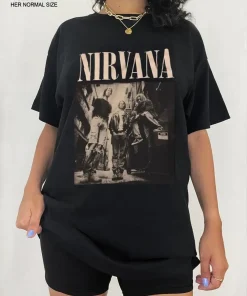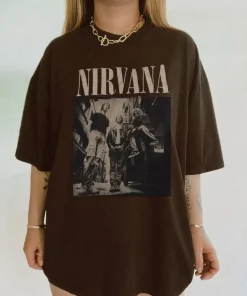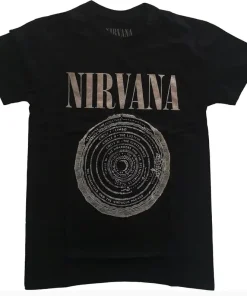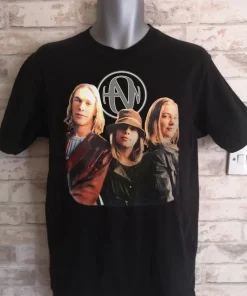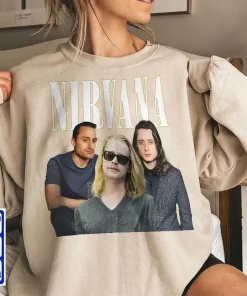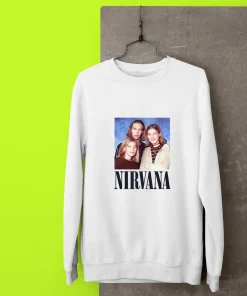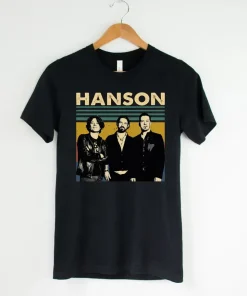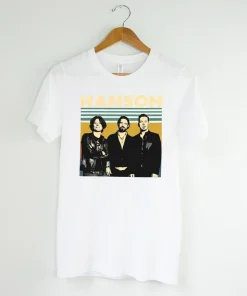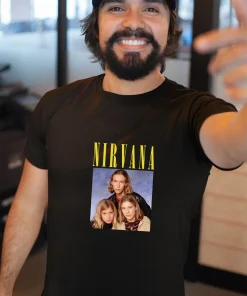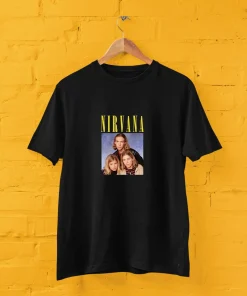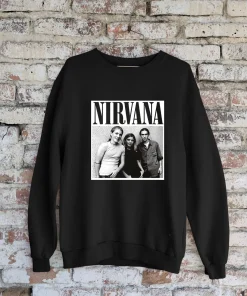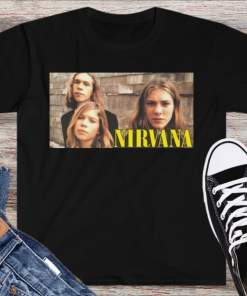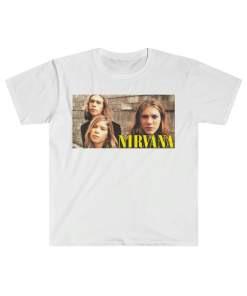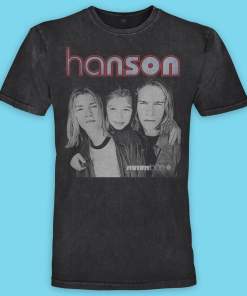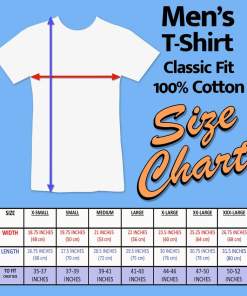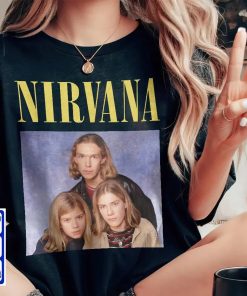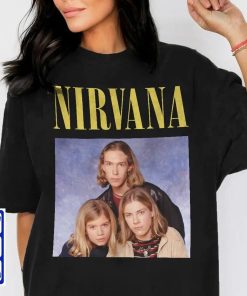Discover the Essence of Fashion – Explore Nirvana Hanson Shirt Collection at Vilo Trend. Nirvana Hanson Shirt at Vilo Trend ✓ Iconic designs ✓ Extensive variety ✓ Hassle-free 30-day returns ✓ Dive into the world of Nirvana Hanson Shirt now! Uncover premium Halloween T-Shirts, uniquely crafted and offered by independent artists, exclusively on Vilo Trend. Experience a spectrum of colors and styles tailored
⏩ You may also love: Walmart Cunt Shirt
Nirvana Hanson Shirt
A. Introduce the topic of the "Nirvana Hanson Shirt"
The convergence of music, fashion, and cultural symbolism has continually shaped our perception of artistic expression and individual identity. One intriguing embodiment of this phenomenon is the "Nirvana Hanson Shirt," a unique fusion of two seemingly disparate musical legacies. In an era where fashion serves as an extension of personal narratives and societal influences, the appearance of this shirt signifies a captivating interplay between nostalgia, creativity, and commercial appeal. The juxtaposition of Nirvana, an iconic grunge band emblematic of the 1990s alternative rock scene, with Hanson, a representative of the late 1990s pop era, encapsulates the mélange of musical tastes and generational influences. This essay delves into the origins, cultural implications, and controversy surrounding the Nirvana Hanson Shirt, exploring how it encapsulates not only the evolution of fashion but also the intricate connections between music genres and their enduring impact on modern popular culture. By examining this unlikely convergence, we unravel the threads that weave together music, fashion, and art into a complex tapestry of meaning and representation.
B. Explain the Reason for Choosing This Topic
The choice of exploring the "Nirvana Hanson Shirt" as a subject of analysis stems from its intriguing nature as a cultural artifact that encapsulates the essence of modern pop culture dynamics. This topic holds significance due to its ability to provoke critical discussions surrounding the intersection of music and fashion, the evolution of artistic representation, and the ever-changing landscape of consumer preferences.
At its core, the Nirvana Hanson Shirt embodies a paradoxical fusion that beckons us to question prevailing norms and challenge conventional boundaries. This choice of juxtaposing the images of Nirvana and Hanson, two bands that not only occupy distinct corners of the musical spectrum but also belong to different eras, beckons us to explore the convergence of divergent artistic influences. This creative collision sparks curiosity, prompting us to delve into how such unexpected combinations reflect the eclectic nature of modern cultural consumption.
Moreover, the popularity and controversy surrounding the Nirvana Hanson Shirt highlight the power of visual symbols to evoke emotions and spark debates. Analyzing the reasons behind the vehement reactions to this amalgamation provides insight into the deep connections individuals forge with the artists, music, and cultural icons they hold dear. By dissecting the reasons for choosing this topic, we embark on a journey to decipher the layers of meaning that underlie seemingly simple sartorial choices, shedding light on the multifaceted relationship between music, fashion, and the human experience.
A. Description of the Nirvana Hanson Shirt
The Nirvana Hanson Shirt stands as a captivating emblem of creative audacity, intertwining the iconic imagery of two vastly different musical worlds. At first glance, the shirt presents an arresting visual paradox—a canvas that harmonizes the unmistakable grunge aesthetics of Nirvana with the vibrant pop essence of Hanson. The garment features a meticulously designed collage: the brooding countenance of Kurt Cobain, the enigmatic frontman of Nirvana, seemingly sharing space with the youthful exuberance of the Hanson brothers.
The composition of the shirt showcases a meticulous attention to detail. Cobain's disheveled hair and introspective gaze contrast starkly with the Hanson brothers' cheerful smiles and coordinated outfits, capturing the essence of their respective genres. The Nirvana side emanates a raw and rebellious energy, characterized by a monochromatic palette and distressed textures. On the flip side, the Hanson imagery exudes a nostalgic charm, adorned with vivid colors and a backdrop reminiscent of 1990s pop aesthetics.
The shirt is not just a confluence of visual elements; it's also a canvas of historical references. The juxtaposition of these distinct musical figures invites viewers to reflect on the evolution of music and its profound impact on culture. The iconic 'smiley face' emblem associated with Nirvana coalesces with the youthful vitality of Hanson, conjuring a powerful commentary on the intergenerational shifts in music and the nostalgia they evoke.
Beyond the visual spectacle, the Nirvana Hanson Shirt embodies a socio-cultural narrative. It beckons us to consider the boundaries of artistic experimentation, urging us to explore the boundaries that define genres and generations. The shirt invites discourse on the fluidity of creative expression and how it can transcend conventional categories. It is a testament to the ever-evolving nature of artistic representation and a testament to the power of fashion as a conduit for dialogue between the past and present.
In essence, the Nirvana Hanson Shirt stands as a unique piece of wearable art, a canvas that intricately weaves together contrasting musical legacies into a tapestry of visual intrigue. It evokes curiosity, challenges preconceptions, and serves as a tangible artifact that mirrors the complexities of contemporary cultural amalgamation.
B. Reasons for the Prevalence of the Nirvana Hanson Shirt in Pop Culture
The enduring prevalence of the Nirvana Hanson Shirt within pop culture can be attributed to a confluence of factors that resonate with contemporary sensibilities and societal dynamics. This unlikely fusion, which might initially appear incongruous, holds a unique charm that captivates diverse audiences and embodies the spirit of artistic evolution.
-
Nostalgia and Retro Resurgence: The shirt taps into a powerful nostalgia that permeates modern culture. Both Nirvana and Hanson represent distinct epochs of the 1990s, a decade that holds a special place in the collective memory. As society revisits the past through a lens of longing, the shirt becomes a conduit for reliving and celebrating these contrasting musical eras.
-
Subversion of Norms: The Nirvana Hanson Shirt challenges established norms and expectations. By blending grunge and pop, it embodies a spirit of rebellion against rigid categorizations. This subversive quality resonates with a generation that values individuality and seeks to break free from conventional constraints.
-
Cultural Hybridity: In an era defined by globalization and interconnectedness, the shirt mirrors the hybrid nature of contemporary culture. It symbolizes the cross-pollination of diverse influences, reflecting a generation that thrives on eclecticism and is unafraid to traverse cultural boundaries.
-
Irony and Humor: The prevalence of the Nirvana Hanson Shirt can also be attributed to its ironic undertone. It wittily juxtaposes two seemingly disparate musical worlds, invoking both contemplation and amusement. This irony appeals to a generation that appreciates wit and clever cultural commentary.
-
Social Media Amplification: The digital age has amplified the impact of visual symbols. The shirt's distinct imagery lends itself well to sharing on social media platforms, facilitating widespread exposure and engagement. Its viral potential highlights the symbiotic relationship between pop culture and digital communication.
-
Generation Z's Artistic Fluidity: The younger generation, particularly Generation Z, embraces a fluid approach to artistic consumption and expression. The Nirvana Hanson Shirt aligns with this mindset by challenging fixed notions of artistic representation, resonating with individuals who value multiplicity and diversity.
-
Consumer Desire for Authenticity: The prevalence of the Nirvana Hanson Shirt also taps into a desire for authentic self-expression. As consumers seek to project their unique identities, wearing the shirt becomes a way to stand out while engaging in a dialogue about the past, present, and the crossover of cultural influences.
A. Discuss the Concept of Band Merchandise
Band merchandise, a prominent aspect of music culture, goes beyond mere clothing and accessories; it serves as a tangible extension of an artist's identity and a bridge between musicians and their fan base. This merchandise encompasses a wide array of products, ranging from T-shirts and hoodies to posters, stickers, and even novelty items like mugs and keychains. The allure of band merchandise lies in its ability to forge a personal connection, facilitating a deeper bond between fans and their favorite artists.
The concept of band merchandise is rooted in the desire for fans to display their affiliation with a particular musical act. Wearing a band's logo or image on clothing becomes a badge of allegiance, signifying not only one's musical preferences but also a sense of belonging to a community that shares similar tastes. This communal identity creates a shared narrative, where fans become part of a larger, interconnected story surrounding the artist's music.
Band merchandise also serves as a means for musicians to extend their artistic expression beyond music. It allows them to visually communicate their aesthetic, ethos, and message. Each piece of merchandise becomes a canvas for translating the essence of their music into a visual form, enabling fans to carry a piece of the artist's creative vision with them. This connection between music and visual representation deepens the emotional resonance of the fan-artist relationship.
Furthermore, the economics of band merchandise plays a pivotal role in sustaining artists' careers. With the music industry undergoing transformations due to digital platforms and streaming, merchandise sales offer a valuable revenue stream for artists, particularly independent ones. The sale of merchandise not only supports touring efforts but also enables artists to invest in their craft and maintain their creative independence.
In recent years, the concept of band merchandise has evolved beyond traditional forms. Collaborations between musicians and fashion designers, as well as limited edition releases, have transformed merchandise into coveted collectibles. This evolution blurs the line between fashion and music, attracting not only dedicated fans but also individuals interested in fashion as a form of self-expression.
In essence, the concept of band merchandise transcends mere commercialism. It encapsulates a symbiotic relationship between artists and fans, transforming clothing and accessories into tangible emblems of shared passion. As music continues to influence culture and ignite emotions, band merchandise remains a dynamic channel through which this cultural phenomenon is celebrated, cherished, and woven into the fabric of everyday life.
B. Analyze How Band Merchandise Becomes a Cultural Symbol
Band merchandise transcends its utilitarian purpose and assumes the role of a cultural symbol, encompassing a multitude of meanings that resonate with individuals and society as a whole.
-
Expression of Individual Identity and Music Preferences: Band merchandise functions as a powerful mode of self-expression, allowing individuals to communicate their identity, values, and affiliations. The choice to wear a specific band's merchandise serves as a visual proclamation of one's musical tastes and aligns with the broader concept of music as a marker of personal identity. For instance, donning a vintage Nirvana T-shirt might signify an affinity for grunge music, a connection to the 1990s era, and an embrace of the counterculture ethos associated with the band. In this way, band merchandise transforms into a canvas through which individuals articulate their unique narrative within the larger tapestry of popular culture.
-
Connection Between Fans and Their Favorite Artists: Band merchandise acts as a tangible link between fans and the artists they admire. It creates a shared language of appreciation and fosters a sense of intimacy. Owning a piece of merchandise embodies a connection with the artist's creativity, values, and artistic journey. Fans often associate memories, emotions, and personal experiences with their merchandise, making it an emotional keepsake that transcends its material form. The merchandise becomes a bridge that spans the gap between the artist's creative output and the impact it has on fans' lives, forming a bond that extends beyond the stage or studio.
-
Reflection of Societal Values and Trends: Band merchandise is not confined to the realm of music; it mirrors broader societal values, trends, and cultural shifts. The choices artists make regarding merchandise design, aesthetics, and collaborations often align with prevailing cultural currents. For instance, merchandise emblazoned with messages of social activism or environmental consciousness reflects the zeitgeist of an era marked by heightened awareness of pressing global issues. Additionally, the resurgence of vintage band merchandise showcases society's inclination toward nostalgia and the cyclical nature of fashion trends. Band merchandise thus becomes a barometer of cultural currents, capturing the spirit of the times and serving as a visual commentary on society's evolving priorities.
In conclusion, band merchandise transcends its surface appearance as clothing or accessories and emerges as a multifaceted cultural symbol. It embodies individual identity, nurtures emotional connections, and reflects the ebb and flow of societal values. This transformation of merchandise into a conduit of cultural expression underscores the profound impact of music on shaping our personal narratives and collective consciousness.
A. Briefly Introduce Nirvana and Hanson as Musical Bands
In the realm of music, few bands have left as indelible a mark on their respective genres as Nirvana and Hanson. These two groups stand at opposite ends of the sonic spectrum, embodying distinct musical styles that have defined their eras and captivated audiences across generations.
Nirvana: Emerging from the Seattle grunge scene in the late 1980s and early 1990s, Nirvana, led by the enigmatic Kurt Cobain, revolutionized the alternative rock landscape with their raw, introspective sound. Characterized by Cobain's gritty vocals and the band's unapologetic approach to music, Nirvana's music delved into themes of alienation, dissonance, and societal critique. Their breakthrough album "Nevermind" and its anthemic single "Smells Like Teen Spirit" catapulted them to international fame, solidifying their status as icons of the grunge movement and shaping the cultural zeitgeist of the early 1990s.
Hanson: On the other end of the musical spectrum, Hanson emerged in the late 1990s as a trio of young brothers—Isaac, Taylor, and Zac—armed with catchy melodies and harmonious vocals. Their debut album "Middle of Nowhere" featured the chart-topping hit "MMMBop," which became an anthem of youthful innocence and optimism. Hanson's music embraced a pop sensibility, characterized by infectious hooks and a feel-good vibe that resonated with a wide audience. Their appeal to the pre-teen and teenage demographic made them a significant presence in the pop music landscape of the late 1990s.
The juxtaposition of Nirvana and Hanson as musical bands encapsulates a stark contrast in sonic aesthetics, lyrical themes, and cultural impact. Nirvana's grunge ethos challenged conventions and epitomized the angst-ridden spirit of a disillusioned generation, while Hanson's pop-driven melodies offered a refreshing counterpoint of youthful exuberance in the midst of a rapidly evolving music industry.
As we delve deeper into the unorthodox amalgamation of their imagery on the Nirvana Hanson Shirt, we peel back layers that reveal not only a commentary on the diversity of musical tastes but also a reflection of the ever-evolving nature of music consumption in an era marked by eclecticism and cross-genre appreciation. This unexpected pairing prompts us to examine the intersections of nostalgia, artistic experimentation, and the broader implications of combining seemingly disparate musical legacies.
B. Highlight the Differences in Their Musical Genres and Fan Bases
Nirvana and Hanson, despite sharing the spotlight of the 1990s music scene, could not be further apart in terms of musical genres and the audiences they attracted.
Nirvana: The hallmark of grunge, Nirvana's music was characterized by its raw intensity, brooding lyrics, and a subversive attitude that resonated with a disenchanted youth culture. Their distinctive sound merged distorted guitars, anguished vocals, and themes of alienation and existential struggle. The band's fan base comprised those drawn to the authenticity of grunge, often seeking an outlet for their frustrations and a voice for their generation's disillusionment.
Hanson: In contrast, Hanson's pop-centric approach embodied youthful optimism and wholesome melodies. Their harmonious vocals, catchy hooks, and family-friendly image attracted a broad spectrum of listeners, predominantly adolescents and pre-teens. The band's appeal lay in their ability to provide an antidote to the heavier themes that dominated the musical landscape, offering an escape into a world of innocence and feel-good tunes.
C. Explore the Irony of Combining Their Images on a Single Shirt
The juxtaposition of Nirvana and Hanson on the same shirt generates a sense of irony that provokes contemplation about the intersection of musical worlds and the changing dynamics of music appreciation.
-
Symbolic Representation of Diverse Musical Tastes: The convergence of these two seemingly incongruous bands on the same shirt becomes a visual metaphor for the spectrum of musical preferences that individuals embrace. It highlights how the boundaries between genres are not rigid but fluid, illustrating that listeners can find resonance in contrasting styles. The shirt becomes a canvas on which these diverse musical tastes coalesce, reflecting the complexity of modern listeners' relationships with music.
-
Commentary on the Eclectic Nature of Modern Music Consumption: In an era defined by streaming platforms and digital access, music consumption has become remarkably eclectic. The amalgamation of Nirvana and Hanson captures this contemporary phenomenon, emphasizing that individuals no longer adhere to a single genre. The shirt serves as a mirror reflecting the era's musical landscape, where playlists can seamlessly transition from grunge anthems to pop ballads, embodying the freedom to explore different sonic realms.
As we consider the irony of their convergence, we recognize that the shirt's subversion of expectations challenges us to view music as a unifying force rather than a dividing one. It encourages us to embrace the diversity of musical expression, fostering a deeper understanding of how seemingly contrasting artists can find a place in the hearts of listeners. The shirt becomes a microcosm of the evolving nature of musical appreciation, inviting us to reflect on our individual journey through the sonic tapestry of past and present.
A. Trace the Historical Evolution of Fashion as a Form of Expression
Fashion, as a form of expression, has a rich and intricate history that mirrors societal changes, artistic movements, and individual identity across centuries.
Ancient Civilizations: The origins of fashion can be traced back to ancient civilizations, where clothing served as more than just a practical necessity. In ancient Egypt, Greece, and Rome, clothing conveyed social status, cultural identity, and religious beliefs. The draping of fabrics, use of colors, and adornments like jewelry reflected an individual's role in society and their connection to the divine.
Medieval and Renaissance Eras: The Middle Ages saw fashion intertwined with class distinctions, with sumptuary laws dictating who could wear certain fabrics and colors. The Renaissance marked a shift towards individualism and artistic expression, with clothing becoming a canvas for self-presentation. Elaborate garments adorned with intricate embroidery and luxurious fabrics showcased one's wealth and aesthetic sensibilities.
18th to 19th Centuries: The 18th century witnessed the emergence of fashion trends driven by the European courts and fashion houses. The Industrial Revolution transformed production methods, allowing for greater accessibility to clothing. The 19th century saw the rise of the fashion magazine and the democratization of fashion, as trends spread beyond aristocratic circles. Clothing was becoming a means to communicate personal taste and adherence to societal norms.
20th Century and Beyond: The 20th century brought rapid changes in fashion, reflecting shifting cultural attitudes. From the rebellious flapper styles of the 1920s to the gender-bending fashions of the 1960s, clothing became a reflection of changing social dynamics. The latter half of the century witnessed the rise of subcultures, each with its own distinctive fashion codes. Punk, hippie, and grunge styles, for example, embodied countercultural sentiments.
In the digital age, fashion is no longer confined to geographical boundaries. Social media and online platforms allow individuals to curate and share their personal style globally. Sustainable fashion movements and the blending of high and street fashion further underline fashion's role as a reflection of contemporary concerns, values, and aspirations.
The historical evolution of fashion showcases its capacity to transcend mere aesthetics. It serves as a cultural mirror, capturing the spirit of each era and illuminating the interplay between the individual and the collective. Just as music is a sonic diary of cultural shifts, fashion is a visual testament to the ever-changing landscapes of society and self-expression.
B. Examine the Role of Clothing in Reflecting Social and Cultural Shifts
-
How Clothing Choices Can Challenge or Reinforce Norms: Throughout history, clothing choices have functioned as powerful tools for challenging societal norms and reinforcing existing ones. Subversive fashion movements, such as the flapper dresses of the 1920s, were emblematic of women's newfound independence during a time of social change. Similarly, the bold androgynous styles of the 1970s challenged conventional gender roles and highlighted the evolving discourse on gender identity. On the flip side, clothing can also reinforce cultural norms, as seen in traditional dress codes that emphasize modesty or hierarchy. The choice to embrace or defy these norms through clothing reflects an individual's agency and their alignment with or resistance against prevailing ideologies.
-
The Concept of "Vintage" and Its Impact on Fashion: The concept of "vintage" clothing has introduced a temporal layer to fashion, allowing the past to shape contemporary style. Vintage clothing not only recalls bygone eras but also acts as a tangible link to history, culture, and nostalgia. Wearing vintage garments signifies a fascination with the past and a desire to embrace the unique aesthetics of different time periods. The popularity of vintage fashion challenges the prevailing notion of constant novelty, highlighting the cyclical nature of trends and the timeless allure of certain styles. Vintage pieces breathe new life into old garments, turning them into artifacts that resonate with modern sensibilities while preserving the narratives of the past.
The role of clothing as a reflection of social and cultural shifts underscores its dynamic significance as a communicative medium. Beyond its utilitarian function, clothing encapsulates stories of rebellion, conformity, innovation, and tradition. It provides individuals with a canvas upon which they can negotiate their identity in relation to broader societal changes. Just as music captures the rhythms of time, fashion stitches together the fabric of history, demonstrating that what we wear is far more than a surface statement—it's a visual representation of the human experience in all its complexities.
A. Diverse Perspectives on the Nirvana Hanson Shirt
-
Support from Nirvana Fans: Some Nirvana fans argue that the Nirvana Hanson shirt is a creative and humorous homage to the iconic band. They appreciate the fusion of two different musical worlds and see it as a tribute to Nirvana's lasting influence on music.
-
Criticism of Commercialization: On the contrary, many critics view the shirt as a prime example of commercialization and the exploitation of a legendary band's image. They argue that it diminishes the authenticity of Nirvana's legacy and reduces it to a marketing gimmick.
-
Hanson's Perspective: Hanson, the band depicted on the shirt, has expressed mixed feelings. Some members appreciate the recognition, seeing it as a form of homage. However, others feel uncomfortable with their image being used in this context and fear it might overshadow their own musical achievements.
-
Intellectual Property Concerns: Legal experts have weighed in on the potential intellectual property issues surrounding the shirt. Some argue that it constitutes fair use and parody, protected by copyright law, while others believe it may infringe on the intellectual property rights of both Nirvana and Hanson.
-
Consumer Opinion: Public opinion is divided, with some consumers finding the shirt amusing and appealing, while others find it tasteless and offensive. Social media has been a platform for passionate debates, with individuals expressing their personal viewpoints.
-
Artistic Expression vs. Insensitivity: The shirt's defenders claim it is a form of artistic expression, blurring the lines between art and satire. Detractors argue that it's insensitive to the legacies of both bands and question the ethical boundaries of such creative liberties.
-
Cultural Commentary: Some scholars and cultural critics see the shirt as a commentary on the evolving nature of popular culture, where the past and present collide in unexpected ways. They argue that it reflects the nostalgia-driven nature of contemporary consumerism.
-
Marketing and Sales Impact: Retailers and marketers have reported mixed results in terms of sales and consumer reception. Some have seen increased interest and revenue, while others have faced backlash and boycotts from certain demographics.
These diverse viewpoints shed light on the multifaceted controversy and criticism surrounding the Nirvana Hanson shirt, highlighting the complex interplay of art, commerce, and cultural interpretation in today's society.
B. Discuss the Nature of Controversy in the Context of Pop Culture
The controversy surrounding the Nirvana Hanson shirt serves as a compelling case study to explore the dynamics of controversy within the realm of pop culture. It encapsulates several key aspects of how controversy arises, evolves, and impacts modern society.
1. Intersection of Icons: Pop culture often thrives at the intersection of various cultural icons and references. The shirt's controversy demonstrates how the fusion of Nirvana and Hanson, two vastly different musical phenomena, can spark intrigue and debate. Pop culture frequently borrows from the past to create something new, and this fusion exemplifies that trend.
2. Commercialization and Authenticity: Controversy often arises when the authenticity of cultural elements is questioned due to commercialization. The debate over the Nirvana Hanson shirt reflects concerns about the commercial exploitation of iconic bands for profit. This issue is a recurring theme in pop culture, where nostalgia and capitalism often collide.
3. Artistic Expression vs. Offensiveness: Pop culture controversies frequently hinge on the blurred lines between artistic expression and offensiveness. The shirt's defenders argue for its artistic and satirical value, while its critics perceive it as offensive. This tension is inherent in much of contemporary pop culture, where artists push boundaries and challenge norms.
4. Intellectual Property and Fair Use: The controversy highlights the legal complexities of intellectual property in pop culture. Whether it constitutes fair use or copyright infringement is a question often debated in the creative industries. This legal dimension is a common thread in many pop culture controversies.
5. Social Media Amplification: In today's digital age, social media plays a pivotal role in magnifying pop culture controversies. The debates and discussions surrounding the shirt have spread widely on platforms like Twitter, Facebook, and Instagram, illustrating how controversy can quickly gain traction and reach a global audience.
6. Consumer Opinions and Brand Impact: Pop culture controversies often have a direct impact on consumer behavior and brand image. The varying opinions on the shirt have influenced consumer choices and retail outcomes. This is a testament to the power of public perception in shaping the success or failure of pop culture phenomena.
7. Cultural Commentary: Controversy in pop culture frequently serves as a lens through which society reflects on its values and beliefs. The shirt's controversy raises questions about the significance of nostalgia, the changing nature of music, and the role of consumerism in shaping cultural narratives.
In conclusion, the controversy surrounding the Nirvana Hanson shirt exemplifies the intricate interplay of elements within pop culture. It showcases how the collision of iconic references, commercialization, artistic expression, legal issues, social media, consumer sentiment, and cultural commentary can create a complex and captivating narrative within the realm of pop culture. This controversy serves as a microcosm of the larger forces at play in shaping the ever-evolving landscape of popular culture.
A. Explore the Connection between Music, Fashion, and Art
The intersection of music, fashion, and art forms a vibrant and dynamic nexus of creativity and self-expression. This connection has been a powerful and influential force in shaping culture throughout history and continues to evolve in contemporary society. Here, we delve into the intricate relationship between these three realms:
1. Expression of Identity:
-
Music: Music is a deeply personal and emotional form of expression. Artists use lyrics, melodies, and rhythms to convey their thoughts, feelings, and experiences. Through their music, artists often establish a unique identity, and this identity can extend beyond the auditory experience to influence other aspects of their persona.
-
Fashion: Clothing and style serve as visual manifestations of one's identity. Musicians often use fashion to project their individuality and create a memorable image. Iconic fashion choices become synonymous with certain artists and genres, allowing fans to connect with their favorite musicians on a visual level.
-
Art: Visual art also plays a role in identity expression. Artists, whether they create album covers, stage designs, or visual representations of their music, use art to communicate themes, moods, and concepts that complement their musical creations.
2. Cultural and Historical Significance:
-
Music: Music reflects the cultural and historical context in which it is created. Different genres and eras of music often have distinct fashion and art associated with them. For example, the psychedelic rock of the 1960s was closely tied to the counterculture fashion and psychedelic art of that period.
-
Fashion: Fashion trends are influenced by the music of the time. Punk music, for instance, gave rise to the punk fashion movement, characterized by leather jackets, torn clothing, and distinct hairstyles. Fashion serves as a visual marker of cultural movements.
-
Art: Artists often draw inspiration from music, using it as a muse for their creations. Paintings, sculptures, and other art forms have been directly influenced by musical compositions, resulting in interdisciplinary collaborations that bridge the gap between the auditory and visual arts.
3. Visual Branding and Marketing:
-
Music: Musicians and bands leverage fashion and art to build their visual brand. Album covers, promotional photos, and music videos are critical in creating a recognizable and marketable image. These visuals can convey the essence of the music and attract a wider audience.
-
Fashion: Music can drive fashion trends, and fashion can reciprocally boost music sales. Collaborations between musicians and fashion designers often lead to exclusive clothing lines and collections that capitalize on the artist's popularity.
-
Art: Artistic elements are often incorporated into album artwork, concert posters, and stage designs. These visuals become integral parts of the overall artistic experience and contribute to the artist's legacy.
4. Pushing Boundaries and Challenging Norms:
-
Music: Musicians frequently push the boundaries of conventional music genres, experimenting with sound and lyrics. This creative exploration can inspire unconventional fashion choices and avant-garde art that challenge societal norms.
-
Fashion: Fashion designers often collaborate with musicians to create avant-garde and boundary-pushing looks. These collaborations blur the lines between fashion and art, resulting in wearable art pieces that challenge traditional notions of clothing.
-
Art: Artists, inspired by music, have produced groundbreaking and experimental works that incorporate audiovisual elements, such as multimedia installations or interactive art pieces, allowing viewers to engage with art in new and innovative ways.
In summary, the connection between music, fashion, and art is a multifaceted and symbiotic relationship. These creative realms influence and enrich one another, providing a platform for individuals and cultures to express themselves, reflect their times, and challenge conventional norms. This interplay continues to shape the cultural landscape, fostering innovation and diversity in the world of creativity.
B. Highlight Examples of Unconventional Collaborations
1. Musician-Designed Fashion Lines:
-
Pharrell Williams and Adidas: Pharrell Williams, the renowned musician and fashion influencer, has collaborated extensively with Adidas. He designed the "Pharrell x Adidas" clothing and footwear collections, featuring colorful and bold designs. His collaborations have transcended typical celebrity endorsements, establishing him as a legitimate fashion designer with a unique aesthetic.
-
Kanye West's Yeezy: Kanye West, a music icon, ventured into fashion with his Yeezy brand in collaboration with Adidas. Yeezy has become a global fashion phenomenon, known for its minimalist and utilitarian designs. This collaboration exemplifies how musicians can successfully transition into the world of high fashion.
-
Beyoncé and Ivy Park: Beyoncé launched her activewear brand, Ivy Park, in collaboration with Adidas. The brand combines fashion, athleticism, and empowerment, reflecting Beyoncé's persona. This collaboration demonstrates how musicians can leverage their image to create fashion lines with a strong message.
2. Artistic Interpretations of Album Covers:
-
The Beatles' "Sgt. Pepper's Lonely Hearts Club Band": The iconic album cover for "Sgt. Pepper's Lonely Hearts Club Band" was designed by artist Peter Blake and his wife, Jann Haworth. It featured a collage of famous figures and artistic references, showcasing a fusion of pop culture and fine art.
-
Pink Floyd's "The Dark Side of the Moon": The album cover for "The Dark Side of the Moon" was designed by Storm Thorgerson and Hipgnosis. It is a famous example of album cover art as a standalone work of art. The prism and spectrum design became instantly recognizable and is often referenced in popular culture.
-
Joy Division's "Unknown Pleasures": The album cover for "Unknown Pleasures" is an iconic example of minimalistic and abstract album art. Created by designer Peter Saville, it features a series of pulsar waves. This cover has inspired numerous artistic interpretations and adaptations.
-
Radiohead's "OK Computer": Radiohead's album "OK Computer" featured a cryptic and evocative cover created by Stanley Donwood. The cover art captured the album's themes of technology and existentialism and has become a symbol of the band's aesthetic.
These examples showcase how album covers transcend their utilitarian purpose to become artistic statements in their own right. Collaborations between musicians and visual artists have resulted in iconic and enduring images that resonate with audiences far beyond the realm of music. These collaborations demonstrate the power of merging music and visual art to create something greater than the sum of its parts.
A. Summarize the key points discussed in the essay
In the essay, we explored the intricate connections between music, fashion, and art, highlighting how these realms intersect and influence each other. The key points discussed are as follows:
1. Expression of Identity:
- Music, fashion, and art are potent mediums for individuals and artists to express their identities. Musicians use lyrics, melodies, and rhythms to convey emotions and create a unique persona. Fashion serves as a visual manifestation of identity, while art complements and enhances this expression.
2. Cultural and Historical Significance:
- Music, fashion, and art are deeply intertwined with culture and history. They reflect the times in which they are created and often embody the spirit of their respective eras. These three realms influence and inspire each other, resulting in distinct cultural movements and trends.
3. Visual Branding and Marketing:
- Musicians, fashion designers, and artists use visual branding to create recognizable and marketable images. Album covers, fashion choices, and art installations serve as powerful tools in shaping an artist's public image and attracting a broader audience.
4. Pushing Boundaries and Challenging Norms:
- The worlds of music, fashion, and art frequently push boundaries and challenge societal norms. Musicians experiment with sound and lyrics, fashion designers create avant-garde looks, and artists produce groundbreaking works that incorporate audiovisual elements, resulting in innovative and boundary-breaking collaborations.
5. Unconventional Collaborations:
- We explored examples of unconventional collaborations, such as musician-designed fashion lines (e.g., Pharrell Williams and Adidas, Kanye West's Yeezy, Beyoncé and Ivy Park) and artistic interpretations of album covers (e.g., The Beatles' "Sgt. Pepper's Lonely Hearts Club Band," Pink Floyd's "The Dark Side of the Moon," Joy Division's "Unknown Pleasures," Radiohead's "OK Computer"). These collaborations illustrate how music, fashion, and art can merge to create impactful and enduring cultural phenomena.
In essence, the essay underscores the profound and multifaceted relationship between music, fashion, and art, emphasizing their role as channels for personal and cultural expression, historical reflection, branding and marketing, boundary-pushing creativity, and unconventional collaboration. This interplay continues to shape and enrich our cultural landscape, offering a diverse tapestry of creativity and innovation.
B. Emphasize the Complex Nature of Cultural Symbols like the Nirvana Hanson Shirt:
The controversy surrounding the Nirvana Hanson shirt, explored within the context of music, fashion, and art, underscores the intricate and multifaceted nature of cultural symbols. This seemingly simple piece of clothing has sparked debates on artistic expression, commercialization, intellectual property, and societal values. It serves as a poignant reminder that cultural symbols are not static; rather, they evolve and adapt in response to the shifting currents of contemporary society.
C. Conclude with a Thought-Provoking Statement about the Ever-Changing Landscape of Pop Culture and Its Impact on Artistic Expression and Consumer Trends:
As we reflect on the intersection of music, fashion, and art, and the unconventional collaborations that emerge from this dynamic interplay, we must recognize the ever-changing landscape of pop culture. Pop culture is a living, breathing entity that mirrors our collective values, desires, and aspirations. It shapes and is shaped by the artists who dare to push boundaries and the consumers who seek to express their individuality.
In this constantly evolving realm, artistic expression transcends traditional boundaries, and consumer trends are both influenced by and influence the creative process. The Nirvana Hanson shirt and similar phenomena remind us that the lines between music, fashion, and art are porous and mutable. As we journey further into the 21st century, it is certain that new collaborations will emerge, challenging conventions, redefining norms, and offering us fresh perspectives on the ever-unfolding tapestry of pop culture. This is a testament to the enduring power of creativity and innovation in our world, where the fusion of music, fashion, and art continues to captivate, inspire, and provoke thought.

